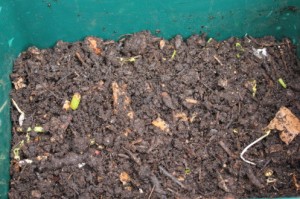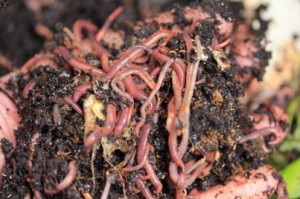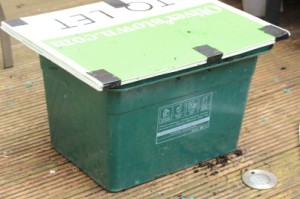12 Feb What’s wiggly and pink and birds like to eat: Part 2 of 2
 Worms
Worms
6. Add about half a bucket of worm bedding – enough to cover about an inch in the bottom of your box. The bedding is what your worms will live in when you first put them into the box. You can use worm compost, home made compost, shop bought compost, or coir (coconut fibres) as bedding. The bedding is important to help your worms ‘settle in’ to their new home. They’ll feel happiest in worm compost. That’s because it contains all the microbes that they need. If you’re lucky enough to have a friend with a wormery (see below) ask for some worm compost to use as bedding. Whatever bedding you use, make sure it is damp, like a rung out flannel. This is partly decomposed worm compost from another wormery. It makes good bedding for worms. But worm compost is not essential – there are other alternatives.
 7. Add some worms: You can get the right sort of worms on line, from a fishing tackle shop, or a compost heap. Even better, from someone you know with a wormery. An established, healthy wormery will contain several thousand worms. Collect 300 – 500 of these, or as many as you can. The more you start with, the faster your wormery will become productive (worms double their population about once every three months – so your friends wormery will return to full power again in just a few weeks). NB: earthworms – the worms you dig up in garden soil – are not suitable for wormeries. A common name for the worms you use in wormeries is Tiger worms. Various varieties are suitable. You only need one variety, but if you have more than one your wormery can be more efficient. Two common species used are: Dendrobaena venata and Eisenia fetida
7. Add some worms: You can get the right sort of worms on line, from a fishing tackle shop, or a compost heap. Even better, from someone you know with a wormery. An established, healthy wormery will contain several thousand worms. Collect 300 – 500 of these, or as many as you can. The more you start with, the faster your wormery will become productive (worms double their population about once every three months – so your friends wormery will return to full power again in just a few weeks). NB: earthworms – the worms you dig up in garden soil – are not suitable for wormeries. A common name for the worms you use in wormeries is Tiger worms. Various varieties are suitable. You only need one variety, but if you have more than one your wormery can be more efficient. Two common species used are: Dendrobaena venata and Eisenia fetida
 8. Add a small supply of food: tea bags, banana skins, vegetable peelings, coffee grounds, are all good. If you chop it up, the worms will be able to process it faster (don’t liquidise though). You can also add processed and cooked food to a wormery – but avoid adding in any quantity, particularly until your wormery is well established. Also avoid adding onion skins, citrus, very spicey or oily foods. As well as food waste, you need to add about 20 – 30% carbon rich matter – carboard, newspaper or wood chip. Vegetable peel, banana skins, pea pods, tea and coffee grounds, a bit of pasta – all good food for worms.
8. Add a small supply of food: tea bags, banana skins, vegetable peelings, coffee grounds, are all good. If you chop it up, the worms will be able to process it faster (don’t liquidise though). You can also add processed and cooked food to a wormery – but avoid adding in any quantity, particularly until your wormery is well established. Also avoid adding onion skins, citrus, very spicey or oily foods. As well as food waste, you need to add about 20 – 30% carbon rich matter – carboard, newspaper or wood chip. Vegetable peel, banana skins, pea pods, tea and coffee grounds, a bit of pasta – all good food for worms.
 9. Cover the surface of the worms. Any old cardboard, newspaper or an old towel will do. This helps keep the light out and the moisture in. Here cardboard is being used as a cover – but an old T shirt, towel, or simply some newspaper will do the job just as well. I sometimes give it a quick watering to keep it damp.
9. Cover the surface of the worms. Any old cardboard, newspaper or an old towel will do. This helps keep the light out and the moisture in. Here cardboard is being used as a cover – but an old T shirt, towel, or simply some newspaper will do the job just as well. I sometimes give it a quick watering to keep it damp.
 10. Add the lid. I’d lost the lid for this box, so I’m improvising with an estate agents sign I found discarded in the road. I’ve sandwhiched two pieces of board together with a gap between them. I drilled holes in the bottom piece so that air can get in, but not in the top to keep it waterproof – at least that is the theory! This lid is improvised from an estate agent sign. It’s functional rather than beautiful – and I will be tucking this one out of sight under a small table!
10. Add the lid. I’d lost the lid for this box, so I’m improvising with an estate agents sign I found discarded in the road. I’ve sandwhiched two pieces of board together with a gap between them. I drilled holes in the bottom piece so that air can get in, but not in the top to keep it waterproof – at least that is the theory! This lid is improvised from an estate agent sign. It’s functional rather than beautiful – and I will be tucking this one out of sight under a small table!
That’s it. All you need to do now is place it in a shady, sheltered spot out of direct sunlight. Feed it a little and often to begin with. Take care not to add too much food at one time or it will become smelly and unattractive to the worms (it putrefies). I plan to write more on caring for wormeries in the future – in the meantime, here’s a piece, In love with worms, that I wrote a while ago with some ideas on what to feed them.
Making your wormery look attractive
I’d be the first to agree that this is not the most beautiful model! So you might want to tuck it out of the way eg under a table. Alternatively you could decorate the plastic box or put plant pots on the top. If you want a more attractive wormery, I’d recommend buying or making one from wood. Wooden wormeries can also double up as benches – and make ideal seating for small spaces. Wood is also a better insulator than plastic and it breathes better, too. But a plastic box will work fine and is so easy to make, that’s why I chose to describe here.
Source: Vertical Veg


